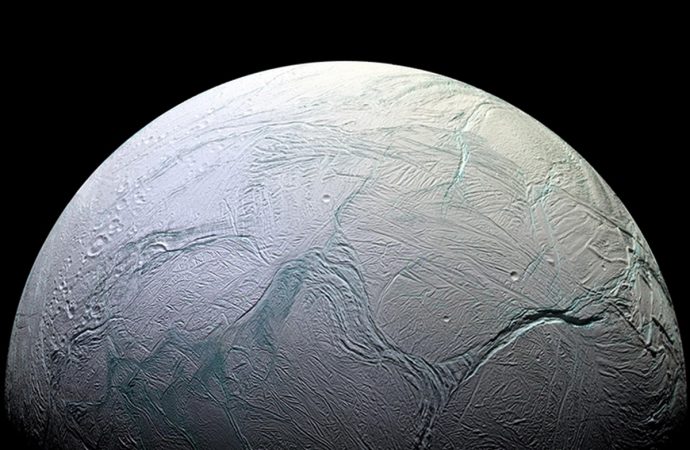Enceladus is ripe for life. In one final pass through the icy moon’s liquid plumes, NASA’s Cassini spacecraft found molecular hydrogen, which indicates favourable conditions for life in Enceladus’s subsurface sea.
For over a decade, Cassini has been exploring Saturn and its moons, sending back the best pictures and measurements we’ve ever had of the system. It dropped off the Huygens probe at hazy Titan, scrutinised the structure of Saturn’s rings, and revealed that Enceladus was much stranger than anyone expected.
Enceladus’s south pole has strange, warm fractures, and plumes of liquid water coming from an internal ocean many believed was impossible in such a small, cold world. The plumes also contain enticing compounds like organics and carbon dioxide, all necessary for life as we know it on Earth.
Those things represent tantalising hints of habitability. But there was no evidence for an energy source to feed potential life, until now. In extreme environments on Earth, hydrogen can play that role.
“What was missing to complete the story of habitability was an energy source,” says Chris McKay at NASA’s Ames Research Center in California. “This completes that story.”
Candy for microbes
Cassini did detect hydrogen in early trips through the plumes, but there was no way to determine if it came from the moon itself or from inside the instrument. When particles from the plumes entered the spacecraft’s Ion and Neutral Mass Spectrometer (INMS), they interacted with its titanium walls, producing the same sort of hydrogen as hydrothermal processes would produce under Enceladus’s ocean.
“We didn’t know we were going to do this experiment when we launched Cassini,” says Hunter Waite at the Southwest Research Institute (SwRI) in Texas. So to look for hydrogen, Waite and his team had to put the INMS instrument in a new mode that measured the molecules without allowing them to touch the walls.
Finally, they found the molecular hydrogen they were looking for – and a lot of it. Their findings indicated that there was too much hydrogen to be stored in tiny Enceladus’s ice shell or ocean. That means it must be continuously produced there, probably by hydrothermal reactions similar to those that occur near hot vents at the bottom of Earth’s oceans.
Near those vents on Earth, there is life. Some of Earth’s oldest microorganisms, called methanogens, are often found near hydrothermal vents where, deprived of light and oxygen, they convert hydrogen and carbon dioxide to methane.
“If you were to take methanogens from Earth’s ocean and transport them to Enceladus, they would have all the food they need,” says Waite. “This is like candy for microbes.” If Earth microbes could exist on Enceladus, maybe it could have homegrown life, too.
Between its liquid water, organic molecules, and hydrogen, Enceladus is looking more and more like our best bet for finding extraterrestrial life. “If we’re looking for life in the solar system, then Enceladus has a lot of potential to be the place that we could find it,” says Kelly Miller at SwRI, who was part of the team that discovered Enceladus’ molecular hydrogen.
Signs of life?
Showing Enceladus is habitable is one thing, finding life is quite another.
“Just because a place is suitable for life doesn’t mean that life is present, because we don’t understand the origin of life at all,” McKay says.
Some believe that life is inevitable, given the right conditions. Others think that it is rare and requires a great deal of luck. Right now, our sample of definitely habitable worlds has only one: Earth. But pairing observations of Enceladus with our own planet could help astrobiologists figure out the likelihood of life existing elsewhere in the universe.
“The message is in the molecules,” says Christopher Glein, another member of Waite’s group at SwRI. “We just have to keep measuring the molecules in that plume, and that’s going to tell us about what we cannot see.”
We won’t have any more molecules from Enceladus’s plumes for a long time, though. Cassini is running low on fuel, and if it were to crash into Enceladus it might destroy any extraterrestrial ecosystem living there. To protect potential life on Saturn’s ocean moons, we have to destroy the only tool we have to find it. The spacecraft will crash into Saturn on 15 September.
Even if an Enceladus mission is selected in NASA’s next round of New Frontiers funding, to be announced in 2019, it wouldn’t reach the Saturn system until the late 2020s or early 2030s.
“To address whether there is life, we’ll have to go back,” McKay says. “Two decades can go by pretty fast.”
Source: New Scientist

































Leave a Comment
You must be logged in to post a comment.